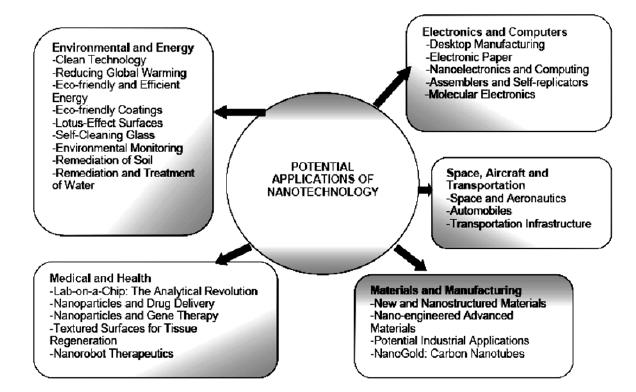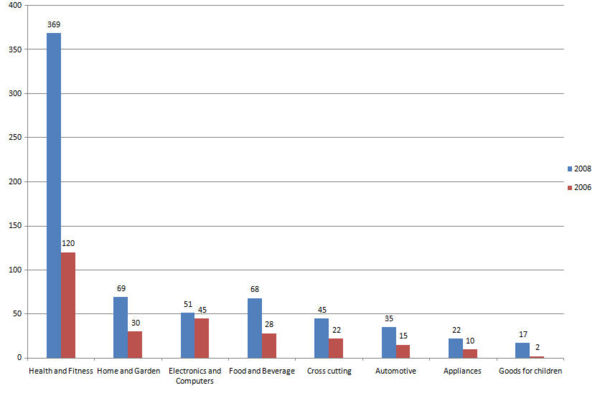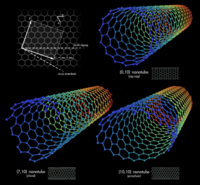Carbon Nanotubes (CNT)
Contents
[hide]Introduction
Nanotechnology
Nanotechnology refers broadly to a field of applied science and technology whose unifying theme is the control of matter on the atomic and molecular scale, normally 1 to 100 nanometers, and the fabrication of devices with critical dimensions that lie within that size range.
Run of Nanotechnology
- December 29, 1959: The first thought of Nanotechnology was given by Richard Feynman in "There's Plenty of Room at the Bottom" at an American Physical Society meeting at Caltech.
- September, 1981: First technical paper published on molecular nanotechnology. The same year scanning tunneling microscope (STM) invented.
- 1982-1990:Books and prizes on nanotechnology. Atomic force microscope invented in 1986.
- 1991: Carbon Nanotubes (CNT's) discovered.
- 1997: First company on nanotechnology founded, it's name is Zyvex.
- 1998-2007: Research, investment, conferences and meetings on nanotechnology.
Applications of Nanotechnology
It has or will have applications in almost all areas we can think of.
- Aerospace
- Medicine
- Identifying location of cancers cells. [1]
- Delivering chemotherapy drugs directly to cancer cells.[2]
- Nanoshells that concentrate the heat from infrared light to destroy cancer cells with minimal damage to surrounding healthy cells. [3]
- Nanotubes used in broken bones to provide a structure for new bone material to grow.[4]
- Nanoparticles that can attach to cells infected with various diseases and allow a lab to identify, in a blood sample, the particular disease.[5]
- Food Storage
- Clay nanocomposites are being used to provide an impermeable barrier to gasses such as oxygen or carbon dioxide in lightweight bottles, cartons and packaging films.
- Food storage bins are being produced with silver nanoparticles embedded in the plastic. The silver nanoparticles kill bacteria from any food that was previously stored in the bins, minimizing health risks from harmful bacteria.[6]
- It is possible to use nanosensors in plastic packaging to detect gases given off by food when it spoils. The packaging itself changes color to alert you to food gone bad.
- Agriculture
- Food will be more tastier and healthier using nanaotechnology.[7]
- Research is also being conducted to develop nanocapsules containing nutrients that would be released when nanosensors detect a vitamin deficiency in your body.
- Researchers are also working on pesticides encapsulated in nanoparticles; that only release pesticide within an insect’s stomach, minimizing the contamination of plants themselves.
- Another development being persued is a network of nanosensors and dispensers used throughout a food crop. The sensors recognize when a plant needs nutrients or water, before there is any sign that the plant is deficient. The dispensers then release fertilizer, nutrients, or water as needed, optimizing the growth of each plant in the field one by one.
- Chemistry
- Semiconductor devices
- Optics
- The first sunglasses using protective and antireflective ultrathin polymer coatings are on the market.
- Nanotechnology also offers scratch resistant surface coatings based on nanocomposites.
- Nano-optics could allow for an increase in precision of pupil repair and other types of laser eye surgery.
- Textile
- The use of engineered nanofibers already makes clothes water- and stain-repellent or wrinkle-free.
- Textiles with a nanotechnological finish can be washed less frequently and at lower temperatures.
- Nanotechnology has been used to integrate tiny carbon particles membrane and guarantee full-surface protection from electrostatic charges for the wearer.
- Consumer products
- Nanotechnology is now entered in almost all consumer products,for details see [11]
Carbon Nanotubes
Carbon Nanotubes (CNT's) are cylindrical shaped allotrope of carbon with length to diameter ratio exceeding 1,000,000.
Such cylindrical carbon molecules have novel properties that make them potentially useful in many applications in nanotechnology, electronics, optics and other fields of materials science. They exhibit extraordinary strength and unique electrical properties, and are efficient conductors of heat.


